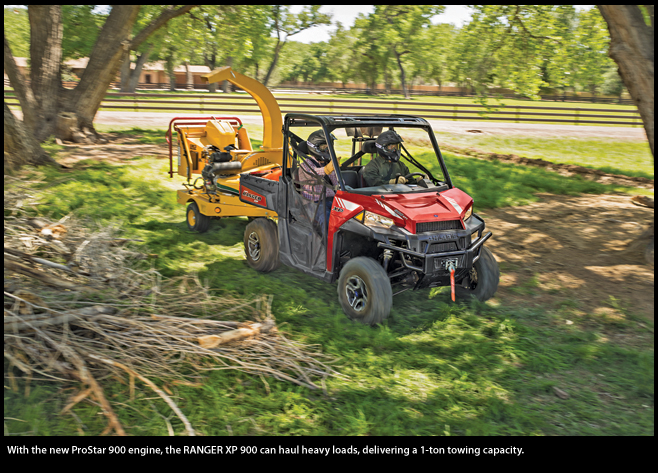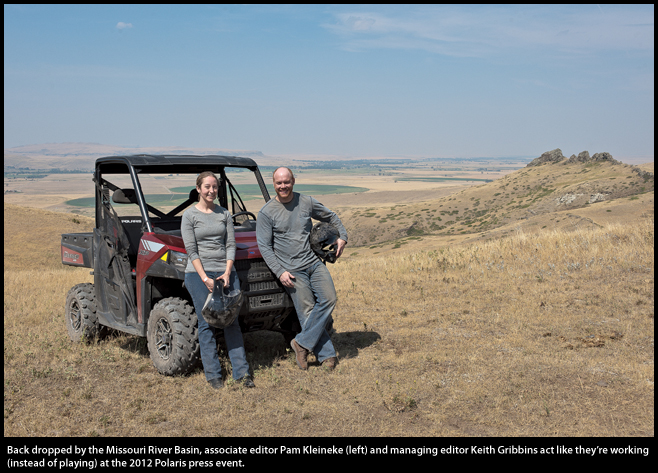2012 Polaris Press Event
Great Falls, Montana, has a rich tradition of famous explorers — the Lewis and Clark expedition famously visited the site in 1805 while on the first recorded transcontinental expedition to the Pacific coast. In 2012, the Kleineke and Gribbins expedition finally found its way to the Montana section of the Missouri River Basin. We were outside of Great Falls in mid-August at a Polaris press event, where we test drove the RANGER XP 900, one of the most exciting additions to the utility vehicle market ever.
Both myself (mild-mannered managing editor Keith Gribbins) and associate editor Pam Kleineke explored the Montana Rocky Mountain Front using various versions of the RANGER XP 900 utility vehicle (UTV), traversing trails that were about 100 miles south of the Canadian border. Herds of elk and packs of Montana whitetail peppered the slopes and sightings of bear and rattlesnakes were circulating among the press corps back at camp — the Bull Run Ranch (www.bullrunguestranch.com) — which served as our mobile base of operations.
Before traversing a few mountains with our RANGER XP 900, we pulled Steve Shiebel to the side. As RANGER product manager on the 900, we knew he could give us the lowdown on this powerful entry into the UTV segment.
“The core product development team has been working on this project for about three years,” smiles Shiebel. “It’s really been a culmination of so many of the things we’ve learned in 15 years of RANGER development.”
Polaris product mangers were all wearing similarly big grins. They were calling the new 900 the hardest working, smoothest riding utility vehicle in the market, and the unit is certainly rolling over new territory for the UTV industry. The Polaris brand has become a badge for all-terrain power and fun, but the Polaris nameplate has plenty of work experience too (does anyone remember the old Professional Series marquee?). For starters, the dump bed has a class-leading 1,000-lb cargo capacity, right sized to fit a full pallet. The bed has also been cleverly constructed with integrated box divider slots, an easy tailgate release (with gas assisted dump), carved-in cup holders and the innovative LOCK&RIDE system (where customers can install racks, cabs, toolboxes and other accessories in seconds).
“This morning I need to work. Tonight, I want to recreate. That’s really been the thought process on our LOCK&RIDE system,” says Shiebel. “Things like gun scabbards are great for our hunters out there. Then for professionals, we have things like the LOCK&RIDE cargo boxes with lids, if you want covered storage. All those types of things are very well received from our customers.”
To haul those heavy loads or pull them (the 900 has a 1-ton towing capacity), the RANGER XP 900 delivers a new class of power with its ProStar 900 engine (a crossover from the company’s RZR segment), which churns out 60 hp, a 20 percent increase from the RANGER 800. The new engine has been placed in the rear of the UTV, underneath the cargo bed for easy access (instead of the bench seat). The engine is now ridged coupled to the transmission with vibration isolating bushings, which makes the power plant super quiet (great for already noisy jobsites) and low on vibrations (great for working all day). The normal 60-mph max speed might scare some safety-focused foreman, but Polaris has astutely included its SPEEDKEY technology as an accessory, which plugs right in to the unit’s CAN bus network and limits the RANGER 900 XP’s speed to 25 mph.
“There’s a system that plugs in underneath the seat — plugs right into the diagnostic port,” says Shiebel. “It’s a secondary key system. You turn the yellow key on, and then you remove the key. Then you’ve enabled the SPEEDKEY for the vehicle. Start it up, and it will travel up to and be smooth at 25 miles per hour.”
To complement the ProStar engine, the RANGER XP 900 features a restyled cockpit and chassis aimed at smooth sailing. The redesigned cab fits three people more comfortably. The lower seat (with adjustable driver’s seat on Limited Edition models) and tilt steering gives occupants more options and the new seat belts are definitely easier to use. New center-mounted gauges give the operator one place to look for ride data and the easy access to storage under the seat means tasks are done quicker with more space for more stuff.
The product walk-around was impressive, but not nearly as interesting as the ride. Polaris senior project engineer Kyle Bjorkman was our guide (a former professional snowmobile racer), and he led the Gribbins and Kleineke expedition all over the foothills of the Rocky Mountains. The power and all-terrain character of the RANGER XP 900 is difficult to match. With 12 in. of ground clearance and a 60-hp engine, the UTV can haul heavy loads to any number of hard-to-get-to destinations. The engine in the rear is smart and the 900 is maybe the quietest on the market. Unfortunately, there is no diesel engine or 6×6 option; customers will still have to turn to the 800 Series to find those types of units.

And while the LOCK&RIDE system is impressive (especially the new cabs, which take two minutes to install), Polaris has moved away from front attachments and rear implements on UTVs (while brands like Kubota and Bobcat move steadily ahead in those arenas). The RANGER XP 900’s new chassis is definitely more rigid, with increased torsional stiffness. It delivers a smoother ride and low vibration, which can be matched with a power steering option (see the Kleineke Report on the previous page). Overall, the RANGER XP 900 is one of the most impressive UTVs we’ve seen in a while (pricing starts at $12,999). It’s certainly a vehicle that’s used for both work and play, so we definitely suggest professional contractors invest in the SPEEDKEY technology if they decide to purchase.
Keith Gribbins is managing editor of Compact Equipment, based in Peninsula, Ohio.





